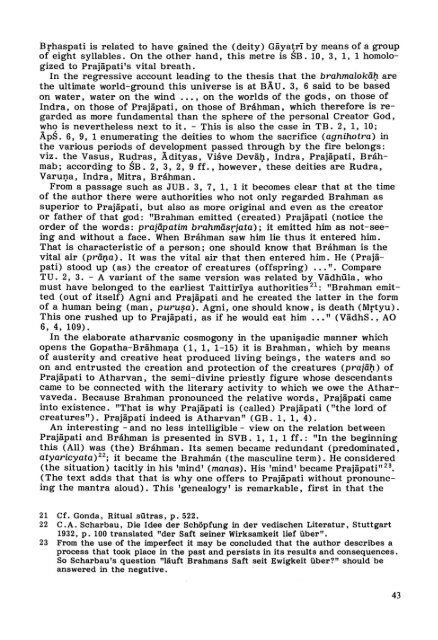Prajapati's relations with Brahman, Brhaspati and Brahma - DWC
Prajapati's relations with Brahman, Brhaspati and Brahma - DWC
Prajapati's relations with Brahman, Brhaspati and Brahma - DWC
You also want an ePaper? Increase the reach of your titles
YUMPU automatically turns print PDFs into web optimized ePapers that Google loves.
<strong>Brhaspati</strong> is related to have gained the (deity) Gäya~rï bymeans of a group<br />
of eight syllables. On the other h<strong>and</strong>, this metre is SB. 10, 3, 1, 1 homologized<br />
to Prajäpati 's vital breath.<br />
In the regressive account leading to the thesis that the brahmalokëi1) are<br />
the ultimate world.:..ground this universe is at BÄU. 3, 6 said to be based<br />
on water, water on the wind ... , on the worlds of the gods, on those of<br />
Indra, on those of Prajäpati, on those of Bráhman, which therefore is regarded<br />
as more fundament al than the sphere of the personal Creator God,<br />
who is nevertheless next to it. - This is also the case in TB. 2, 1, 10;<br />
ÄpS. 6, 9, 1 enumerating the deities to whom the sacrifice (agnihotra) in<br />
the various periods of development passed through by the fire belongs:<br />
viz. the Vasus, Ru~ras, Ädityas, Visve Deväl}., Indra, Prajäpati, Bráhmab;<br />
according to SB. 2, 3, 2, 9 ff. , however, these deities are R udra,<br />
VaruI)a, Indra, Mitra, Bráhman.<br />
From a passage such as JUB. 3, 7, 1, 1 it becomes clear that at the time<br />
of the author there were authorities who not only regarded <strong><strong>Brahma</strong>n</strong> as<br />
superior to Prajäpati, but also as more original <strong>and</strong> even as the creator<br />
or father of that god: "<strong><strong>Brahma</strong>n</strong> emitted (created) Prajäpati (notice the<br />
order of the words: prajäpatim brahmäsrjata); it emitted him as not-seeing<br />
<strong>and</strong> <strong>with</strong>out a face. When Bráhman saw him lie thus it entered him.<br />
That is characteristic of a person; one should know that Bráhman is the<br />
vit al air (prä1;w). It was the vital air that then entered him. He (Prajäpati)<br />
stood up (as) the creator of creatures (offspring) ... ". Compare<br />
TU. 2, 3. - A variant of the same version was related by VädhUla, who<br />
must have belonged to the earliest Taittirïya authorities 21 : "<strong><strong>Brahma</strong>n</strong> emitted<br />
(out of itself) Agni <strong>and</strong> Prajäpati <strong>and</strong> he created the latter in the form<br />
of a human being (man, puru~a). Agni, one should know, is death (Mrtyu).<br />
This one rushed up to Prajäpati, as if he would eat him ... " (VädhS., AO<br />
6, 4, 109).<br />
In the elaborate atharvanic cosmogony in the upanü?adic manner which<br />
opens the Gopatha-BrähmaI)a (1, 1, 1-15) it is <strong><strong>Brahma</strong>n</strong>, which by means<br />
of austerity <strong>and</strong> creative heat produced living beings, the waters <strong>and</strong> 80<br />
on <strong>and</strong> entrusted the creation <strong>and</strong> protection of the creatures (prajëi1)) of<br />
Prajäpati to Atharvan, the semi-divine priestly figure whoSe descendants<br />
came to be connected <strong>with</strong> the literary activity to which we owe the Atharvaveda.<br />
Because <strong><strong>Brahma</strong>n</strong> pronounced the relative words, Prajäpati came<br />
into existence. "That is why Prajäpati is (called) Prajäpati ("the lord of<br />
creatures"). Prajäpati indeed is Atharvan" (GB. 1, 1, 4).<br />
An interesting - <strong>and</strong> no less intelligible - view on the relation bet ween<br />
Prajäpati <strong>and</strong> Bráhman is presented in SVB. 1, 1, 1 ff.: "In the beginning<br />
this (All) was (the) Bráhman. lts semen became redundant (predominated,<br />
atyaricyata)22; it became the Brahmán (the masculine term). He considered<br />
(the situation) tacitly in his 'mind' (manas). His 'mind' became Prajäpati" 23.<br />
(The text adds that that is why one offers to Prajäpati <strong>with</strong>out pronouncing<br />
the mantra aloud). This 'genealogy' is remarkable, first in that the<br />
21 Cf. Gonda, Ritual sütras, p. 522.<br />
22 C. A. Scharbau, Die Idee der Schöpfung in der vedischen Literatur, Stuttgart<br />
1932, p. 100 translated "der Saft seiner Wirksamkeit lief über".<br />
23 From the use of the imperfect it may be concluded that the author describes a<br />
process that took place in the past <strong>and</strong> persists in its results <strong>and</strong> consequences.<br />
So Scharbau's question "läuft <strong><strong>Brahma</strong>n</strong>s Saft seit Ewigkeit über?" shouldbe<br />
answered in the negative.<br />
43
















